What is Paintless Dent Repair?
Our Denver Paintless Dent Repair service is a technique used to remove dents from vehicles without repainting the affected area. It involves using tools and techniques to gently massage the dent out from the backside of the panel.
This process is much faster and less expensive than traditional dent repair methods, which require sanding, filling, and repainting the damaged area. Paintless Dent Repair is most effective for small—to medium-sized dents that have not damaged the paint. This technique is widely used by car dealerships, body shops, and car owners who want to restore their vehicles to their original condition.
Paintless Dent Repair for Minor Auto Body Dents
Are you tired of dealing with unsightly dents on your car and want to avoid the hassle and expense of repainting it? Consider paintless dent repair as a solution.
Our paintless dent removal service uses pioneering automotive technology to remove minor dents and “dings” from the body without autobody work or painting. We provide PDR services in Longmont, Erie, Boulder, Frederick, Firestone, Castle Rock, Centennial, Aurora, Parker, and the entire Denver Metro area.
This is an excellent solution, especially for luxury cars like Porsche and BMW. Since small dents can reduce a car’s value by thousands of dollars, Paintless Dent repair is faster than traditional bodywork, resulting in significant cost savings. PDR repair can save you up to 70% compared to the costs of traditional body repair.
Suitable for storm damage, hail damage, supermarket parking lot sounds, shopping cart dents, golf ball accidents, and wind damage. Many dents can be removed entirely, but some can be improved to be less noticeable. In other words, you can avoid the cost of bodywork to repair the panel. Contact ProTech Auto Shield today to learn more.
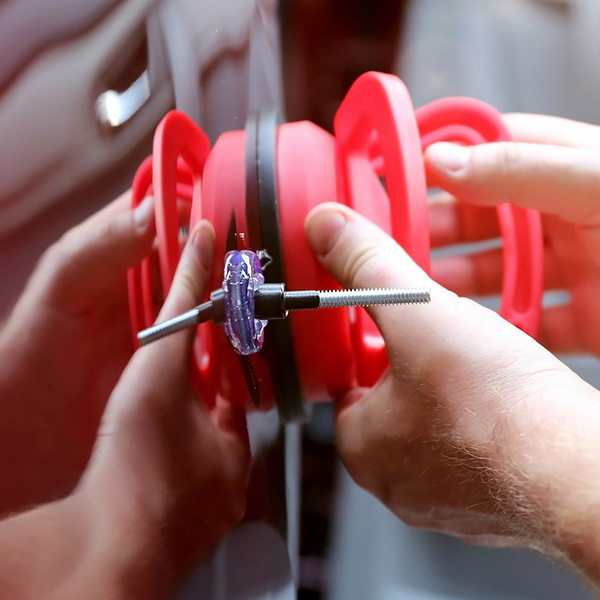
Why Choose ProTech for Paintless Dent Repair?
ProTech Auto Shield has become the top company in the paintless dent repair industry due to our affordable automobile dent repair services.
- Recognized for our innovation of SMART repairs for small to medium areas.
- Our technicians specialize in affordable repairs with PDR, utilizing the latest technology for repairing door dings, dents, and hail damage while preserving your vehicle’s original paint.
- Our technicians undergo intensive PDR training to become skilled professionals in the industry.
- ProTech Auto Shield utilizes special tools to perform a PDR process that can restore your vehicle to its original condition. This process is accomplished at a reduced cost and in less time.
Benefits of Paintless Dent Repair (PDR)
- Quicker than traditional dent repair methods.
- It is a more cost-effective solution as it does not require repainting the entire panel.
- Paintless dent repair retains the vehicle’s original factory finish, maintaining its value.
- It is an environmentally friendly option as it eliminates the need for harsh chemicals used in traditional repair methods.
One of the many advantages of repairing hail damage is that it allows for repairing a wide range of dents, from minor creases to larger dents caused by hail damage. By carefully manipulating the metal back to its original position, skilled technicians can restore the body panel to its original shape without the need for repainting. This means that the original factory paint job is preserved, and the vehicle owner can benefit from an undetectable quality repair.
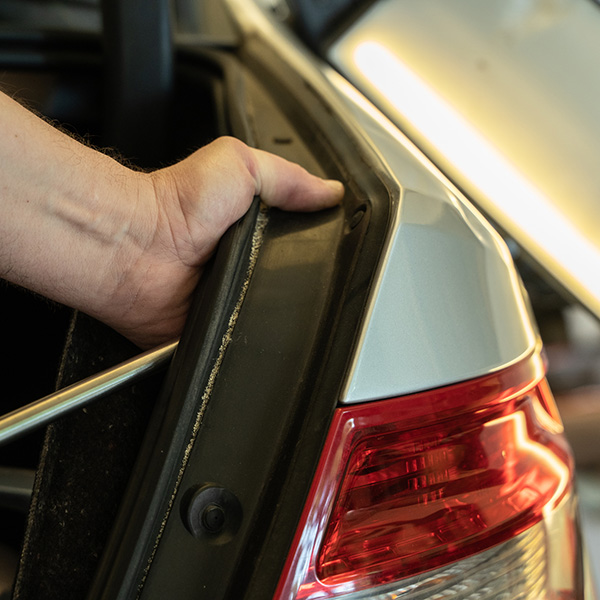
PDR – A Revolutionary Automotive Repair Process
ProTech Auto Shield’s PDR technicians perform vehicle restorations daily, ensuring the original factory condition is maintained, and the painted finish is not compromised while also being cost-effective for consumers.
Here’s How the PDR Process Works:
Step 1: Assessment of the Damage
ProTech’s first step is conducting an initial assessment of the damage. This assessment process is crucial as it helps the technician determine the damage’s extent and decide on the appropriate repair technique to use.
The assessment begins by carefully examining the areas surrounding the dent to ensure no paint damage. This is important because paint damage will require a traditional repair process that entails filling the damaged area with body filler and repainting the scratched surface.
After ascertaining that there is no paint damage, our technician assesses the size and depth of the dent. Special tools such as metal rods and body picks are used to gently push the dent outwards until it pops back into its original position.
It is also crucial to identify the location of the dent, as this will determine the feasibility of using PDR techniques. Dents in areas inaccessible from behind, such as beneath trim pieces, are unsuitable for PDR repairs.
The type of metal used in the body panel must be considered. PDR techniques differ for different metal panels, and the technician must have the experience and knowledge required to apply the correct techniques.
Finally, conducting an initial damage assessment is crucial when repairing a dent using PDR techniques. It enables the technician to determine the appropriate repair technique, identify the location of the damage, and assess the type of metal used in the body panel. This process ensures that the dent is repaired correctly and the vehicle owner is satisfied with the quality of the repair.
Step 2: Accessing the Damaged Area
To repair a dent using paintless dent removal (PDR) methods, the first step is to access the damaged area. This means removing any trim pieces, panels, or other obstacles blocking access to the dent. The goal is to ensure that technicians can see and reach the dent from all angles.
Accessing the damaged area is crucial when repairing dents using PDR methods. The assessment of the extent of the damage is also critical to ensure effective repairs are carried out. Removing obstacles, assessing the damage, and cleaning the area are key elements enabling dent repair professionals to provide quality and excellent customer satisfaction.
Step 3: Utilizing Specialized Tools to Massage and Manipulate the Metal
After identifying the location and nature of the dent, the next step of the paintless dent repair process is to apply specialized techniques and tools to massage and manipulate the metal back to its original position. This technique requires patience, precision, and expertise and is best performed by experienced and skilled technicians.
For minor repairs, the tools used in standard paintless dent repair include metal rods, body picks, and special hand-held tools designed for specific types of dents. These tools are designed to exert pressure in the right direction, gently massaging the metal back to its original position without damaging the paint surface. This advanced technique is an excellent alternative to traditional dent repair methods that rely on body filler and repainting, which can often result in an uneven finish and an alteration of the original factory condition.
Step 4: Finishing Touches and PDR Inspection
Step 4 of the paintless dent repair process involves finishing touches and thoroughly inspecting the repaired area. This step is crucial in ensuring that the repair is flawless and meets the high customer satisfaction standards that professional repair companies aim to achieve.
The finishing touches involve blending the repaired area to match the texture and finish of the rest of the vehicle’s body surface. This is achieved through the use of blending hammers and heat application. The goal is to ensure that no sharp edges or noticeable differences in texture or color can be detected between the repaired area and the surrounding body panel.
In the inspection phase, the experienced technicians go over the repaired area. Attention to detail is crucial, as even the smallest imperfection can compromise the overall quality of the repair. Our technicians will examine the repaired area from different angles and lighting conditions to ensure that everything looks perfect and that the repair is flawless.
At this stage, the final touches are made to ensure that the repaired area matches the original factory finish and is restored to its original position. Any trim pieces or bodylines damage that may have been detached or shifted during the repair process are reattached and checked for proper alignment.
ProTech Auto Shield is committed to providing quality repairs that meet customer expectations. As such, we offer a limited warranty on their workmanship.
What are the Advantages of Paintless Dent Repair Over Traditional Methods?
PDR is Cost-Effective
Paintless dent repair is a more affordable option as it saves costs on paint, labor, and supplies used in traditional methods since there is no need for repainting or filling the dents. This makes it an appealing option for minor repairs like hail damage and small dents that traditional repair methods would consider excessive.
Time-Saving
Paintless dent repair takes less time compared to traditional repair methods, mainly because it does not require repainting or bodywork. In some cases, this process can be completed with same-day service, and the vehicle can be restored to its original condition in less than a few hours.
PDR is Eco-Friendly
Paintless dent repair is eco-friendly since no hazardous chemicals or products are used in the process, unlike traditional methods that use body fillers and paints that are harmful to the environment. Technicians can use specialized tools and techniques to restore the vehicle’s body panels and steel panels without affecting the original factory finish, making it an excellent alternative for environmentally-conscious customers.
Retains the Vehicle’s Value
Paintless dent repair ensures that the vehicle retains its original paint job and factory paint, helping maintain its value. This is especially crucial for lease returns and trade-ins since it minimizes the cost of bodywork and repainting. Additionally, most paintless dent repair companies offer limited lifetime warranties, giving customers peace of mind and boosting customer satisfaction.
Paintless Dent Repair for Hail Damage: A Smart Solution to Preserve Your Vehicle’s Value
Why do we use Painless Dent Repair (PDR) to repair vehicle hail damage? The best way to repair hail damage is through PDR. No filling, polishing, or painting is required, keeping the original integrity of the vehicle maintained.
Paintless dent repair (PDR) is an excellent option for repairing hail damage. This is because it allows the vehicle to retain its original paint job and factory paint, helping maintain its value. Additionally, PDR preserves the vehicle’s original condition and paint surface, as the repair process doesn’t require any body filler or paint repair.
Unlike traditional dent repair methods that involve sanding, filling, and repainting, PDR leaves your vehicle’s factory paint intact, preserving its value and original condition. So, if you want to get rid of those pesky dents caused by hail damage, consider PDR an excellent option that will leave your car looking new again.
Minor Dent Repairs
Minor dents on ]vehicles can be caused by many things, including bicycles, soccer balls], golf balls, and even shopping carts, hail damage from thunderstorms, and of course small rocks while driving. And most likely you don’t want to file an insurance claim for these dents.
Paintless Dent Repair FAQs
What is Paintless Dent Repair (PDR)?
A method of removing dents from a vehicle without using traditional repair methods that involve painting or replacing the damaged area.
What types of dents can be repaired with PDR?
PDR can be used to repair small dings, dents, and creases that are typically caused by hail damage, minor collisions, or other types of minor damage.
Are there any limitations to PDR?
PDR can only be used to repair dents that have not caused any damage to the paint or finish of the vehicle. Additionally, PDR may not be suitable for larger dents or damage that has caused the metal to stretch or warp.
How does PDR work?
PDR involves using specialized tools to carefully massage the damaged area back into its original shape without damaging the paint or finish of the vehicle.
Is PDR expensive?
The cost of PDR will depend on the damage’s severity and the dent’s location. In general, PDR is a cost-effective alternative to traditional repair methods.
How long does it take to complete a PDR repair?
The time required to complete a PDR repair will depend on the damage’s severity and the dent’s location. In general, PDR repairs can be completed in just a few hours.
Will PDR affect the resale value of my vehicle?
No, PDR will not affect the resale value of your vehicle. In fact, PDR is a preferred method of repair by many car dealerships and insurance companies because it is a cost-effective and non-invasive repair method.
Can PDR be done on any vehicle?
PDR can be used on most types of vehicles, including cars, trucks, and SUVs. However, the location and severity of the dent may affect whether PDR is a suitable repair method.
How Do We Remove the Dent Without Repainting?
Using a metal lever to massage the back depression of the body panel (also known as “cold metal repair”) is a skilled task that requires years of training to remove the depression completely. We don’t have to repaint as the dents pop out, keeping the original paint finish. This procedure cannot be used for large metal indentations where the paint surface is damaged; the results of a paintless dent repair to smaller dents on your vehicle is amazing.
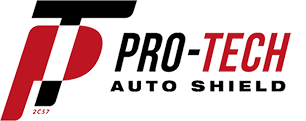



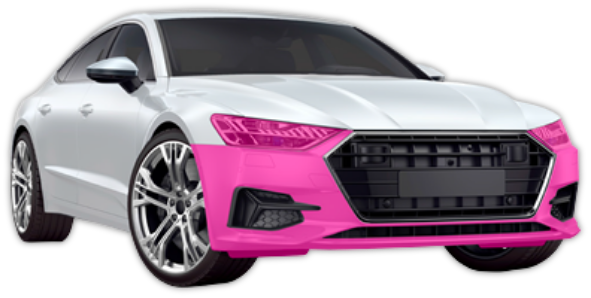
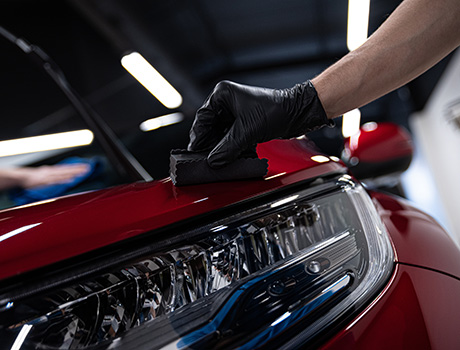
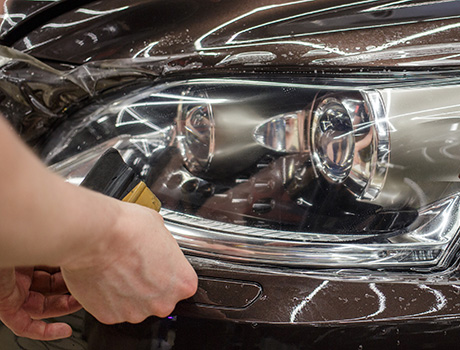

WHAT OUR CLIENTS ARE SAYING